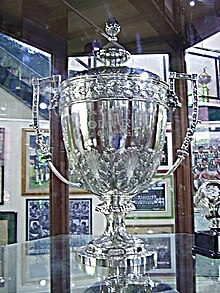Copa Rio
The Torneio Internacional de Clubes Campeões for the Copa Rio was an unofficial football competition to determine a club's world champion. It was organized by the Brazilian football association Confederação Brasileira de Desportos (CBD) in 1951 and 1952.
history
After the World Cup in Brazil in 1950 , the Brazilian Football Association tried to set up a similar competition for clubs. The idea for this came from the journalist Mário Filho . Originally, 16 clubs were to take part, as in the 1950 World Cup in Brazil. In the end there were eight, and then not as planned, representatives of the best countries of the world tournament of 1950, but after cancellations from England, for example, participants such as FK Austria Wien were recruited from Austria. On the other hand - in order to support the clubs there - the current championships were interrupted in São Paulo and Uruguay .
The first tournament took place from June 30th to July 22nd, 1951. The two largest stadiums in the country served as the venue, the Maracanã in Rio and the Estádio do Pacaembu in São Paulo. First two groups were played and then the semifinals and finals with two matches each. Brazilian representative Palmeiras São Paulo was the first to enter the list of winners and the club was presented with the silver trophy by FIFA Secretary General Ottorino Barassi . The second tournament lasted from July 13 to August 2, 1952 and. With Fluminense Rio de Janeiro , another club from Brazil won the competition. The group stage was also played there in two groups, each of which played the games in São Paulo and Rio de Janeiro. In 1952 the group in Rio consisted of Peñarol, the Grasshopper Club Zurich , Sporting Lisbon and Fluminense.
The journalist Luciano Álvarez explains the motivation for the introduction of the tournament to the effect that the tournament was created to restore the international prestige of the Brazilian following the loss of the Brazilians in the 1950s World Cup final. The tournament was characterized by an extremely hostile climate towards the Uruguayan teams and partisan referees, which is why at least Peñarol did not consider participating in this event after 1952. Nacional's participation in this tournament in 1951 was characterized by a very aggressive atmosphere and extremely tough games.
The follow-up event, Torneio Octogonal Rivadávia Corrêa Meyer, took place in small form in 1953. After a football world championship for national teams took place again in 1954 and the European championship was held for the first time a year later in Europe , the club world championship could not be revived. In 2007, at the request of the Brazilian Association, FIFA was seriously considering declaring the Copa Rio as part of the much younger FIFA Club World Championship for a long time , but this ultimately failed.
The tournaments at a glance
| year | final | Semi-finalists | ||||
|---|---|---|---|---|---|---|
| winner | Results | finalist | Finalist Maracanã | Finalist Pacaembu | ||
| 1951 |
|
1: 0/2: 2 |
|
|
|
|
| 1952 |
|
2: 0/2: 2 |
|
|
|
|
Individual evidence
- ↑ Luciano Álvarez: Historia de Peñarol , 1st edition 2005, p. 433
- ↑ Luciano Álvarez: Historia de Peñarol , 1st edition 2005, pp. 433f
Web links
- Details about the 1951 tournament on rsssf.com (English)
- Details about the 1952 tournament on rsssf.com (English)
- Attendances in matches of Copa Rio 1951 (English)
- Attendances in matches of Copa Rio 1952 (English)
